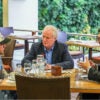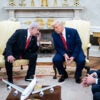Only a few weeks after President Obama’s controversial decision to delay the building of the Keystone XL pipeline, the Obama administration is expected in the next several weeks to approve a 500-mile green energy transmission line project running through Arizona and New Mexico that his own Defense Department says may pose “an unacceptable risk to national security.”
The multibillion-dollar electric power line project, financed by a group called SunZia, would connect wind power facilities in eastern New Mexico to the electric grid and supply power to Arizona and California.
The Daily Signal depends on the support of readers like you. Donate now
About 45 miles of the transmission lines would be located in a “restricted zone” because it would overlap an Army missile testing ground at New Mexico’s White Sands Missile Range.
‘National Security Risk’
Rep. Steve Pearce, R-N.M., says the plan would compromise the military base’s central mission of testing cruise missiles and “create a serious national security risk.” New Mexico Gov. Susana Martinez has also weighed in, saying: “I am seriously concerned that the planned route for the project” poses “an unacceptable national security risk.”
Pearce and Martinez have for many months advised the SunZia management to reroute the power lines in a way that won’t interfere with the army base operations. But the investors have objected on the grounds that drawing up a new course for the lines would be too expensive and lead to years of environmental impact delays.
This line of defense has almost never stopped the government from killing economic development projects in the past.
SunZia has awkwardly pitted two agencies of the Obama administration against each other: the Bureau of Land Management, which is all-in on the White House’s green energy crusade, and the DOD, which warns that the project could jeopardize security operations.
The power line could obstruct vital operations at White Sands, which is the Pentagon’s largest testing station for long-range weapons. DOD has already vetoed the project twice, but the greens in the administration keep agitating for it.
Public Lands For Some
The Obama administration from its first days in office has issued guidelines requiring the Department of the Interior to make public lands available for “renewable energy projects.” It has sided with SunZia and has endorsed the planned route for the transmission that intersects with the military base as the “preferred alternative.”
This is the same Interior Department that has raised myriad obstacles impeding the oil and gas industry’s ability to obtain leasing permits for drilling projects.
In an attempt to resolve the internal Obama administration dispute, the feds last year sponsored a study by researchers at MIT Lincoln Laboratory to examine how great the disruption would be to military testing. That study’s findings were issued last week, but the precise contents have been kept under wraps as “confidential.”
Several sources have read it, and they confirm the negative impact on the missile testing — which may be why the report hasn’t seen the light of day. Rep. Pearce says that the study “well validated” national security concerns and confirms his concern that SunZia could “shut down 30 percent” of the White Sands missile base operations.
Why would a study of a project that its supporters say does not pose a threat to national security be classified as confidential?
Under one draft plan that the Obama administration is pushing, the project would go forward and most of the costs associated with mitigating the transmission line interference with military operations at White Sands would be paid for by DOD, not the SunZia investors.
For example, one way to negate interference from the power lines would be to bury them underground. But that is far more expensive and, under one plan the Obama administration is pushing, DOD may have to absorb about 80 percent of the cost, not the private investors who will profit from the project.
DOD’s resources are already stretched thin from sequester cuts and spending caps that have cut almost $100 billion from its budget in recent years.
The green energy lobby has called in its heaviest of political artillery to get the project approved. In March Senate Majority Leader Harry Reid wrote a letter to Defense Secretary Chuck Hagel and Interior Secretary Sally Jewell that states:
“I have been monitoring the progress of the SunZia transmission line. I understand that over $44 million has been expended on permitting over the last five years, with delays due to the Department of Defense’s reversal of two approvals and unclear guidance from DOD.”
Then he warns: “I strongly suggest that the Department of Defense work collaboratively with the Department of the Interior immediately” to resolve the delays.
What is striking about this debate is that the position of the White House and Harry Reid is diametrically opposite to the reaction to the Keystone XL pipeline.
Harry Reid won’t even allow the pipeline to come up for a vote in the U.S. Senate, but the SunZia dispute should be resolved “immediately.”
On Keystone, the White House announced that the project should not go forward until it can be proven to be in “the national interest.” On SunZia, the White House wants to override critical national security risks to promote green energy.






























